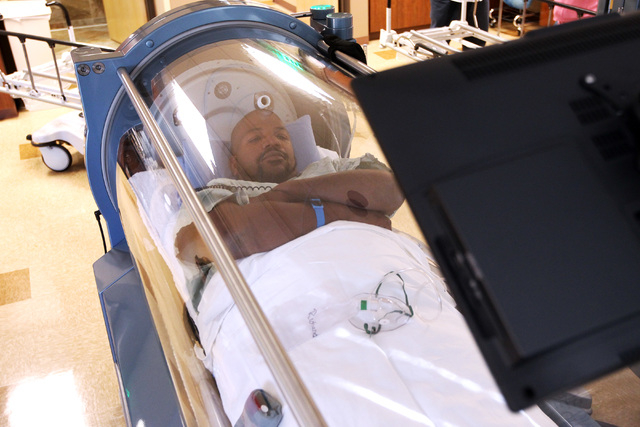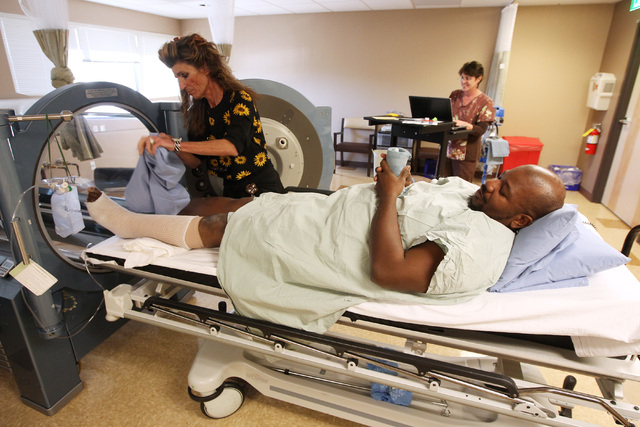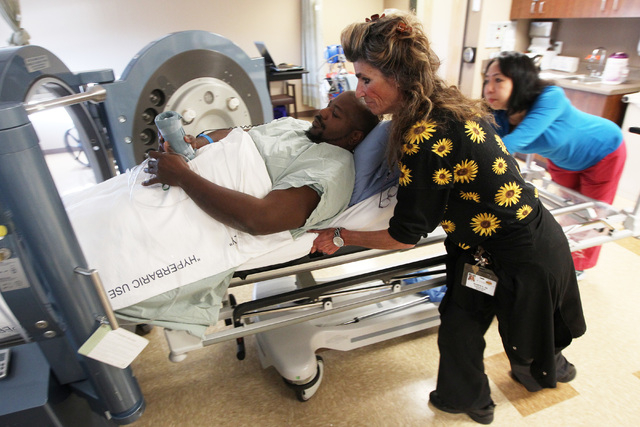Hyperbaric treatment helps with wound recovery
Daniel Richardson is preparing to take a dive without having to deal with the annoyances of scuba equipment, inquisitive sea creatures or, even, having to get wet.
Instead, Richardson’s dive will take place in a hyperbaric oxygen treatment chamber at the Wound Healing &Hyperbaric Center at Valley Hospital, where he’ll spend about two hours lying inside a cylindrical pod, breathing 100 percent oxygen at an atmospheric pressure he’d otherwise have to dive about 33 feet underwater to experience.
Richardson’s decidedly nonaquatic goal: allowing hyper-oxygenated blood to circulate throughout his body to promote the healing of an ulcer on his foot.
The treatment Richardson is undergoing is called hyperbaric oxygen therapy. And during the past several decades, it has evolved from a therapeutic curiosity into a standard mode of care for conditions ranging from diabetic ulcers and hard-to-heal-wounds to carbon monoxide poisoning to complications from radiation therapy.
Several hospitals, wound care centers and private medical practices in the valley offer hyperbaric oxygen therapy. Among them are the Valley Health System, which maintains hyperbaric and wound treatment centers at Desert Springs, Summerlin and Valley hospitals, and the Dignity Health-St. Rose Dominican hospital system, which maintains Wound Healing and Hyperbaric Medicine Centers at its San Martin and St. Rose de Lima campuses.
Dr. Dominic Ricciardi, medical director of the St. Rose San Martin center, notes that hyperbaric oxygen therapy not only is “more available” than it was just a few decades ago, but that continuing research has led to it becoming a “standard of care” for certain medical conditions.
Dr. Lubna Javed, medical director of the Advanced Wound Healing and Hyperbaric Center at Spring Valley Hospital — the valley’s newest hyperbaric treatment option, which opened earlier this month — says hyperbaric technology is an outgrowth of technologies long used in diving to treat decompression sickness, or “the bends,” that can result when divers surface too quickly.
Even today, Riccardi notes, the specialty’s antecedents can be heard in terminology that includes sessions in chambers being referred to as “dives” and references for taking patients “down” at a session’s beginning and “up” at a session’s end.
In hyperbaric oxygen therapy, a patient typically will breathe 100 percent oxygen in a sealed chamber in which the atmospheric pressure has been increased to two- to 2½ two-and-a-half times higher than normal. That leads to an increase in oxygen saturating the blood, and that can improve tissue function, help to create new blood vessels, help to heal wounds and fight infection.
In simple terms, hyperbaric oxygen therapy essentially is “a mode of delivery of oxygen to a wound,” Ricciardi says.
Javed says the most common uses of hyperbaric oxygen therapy at the Spring Valley Hospital center include treatment of chronic bone infections, diabetic foot ulcers, failed skin grafts, crush injuries and chronic wounds.
Other uses for which the U.S. Food and Drug Administration has approved hyperbaric oxygen therapy are gas or air embolisms — “a pocket of air or gas that is within the blood system that can block off an area,” Ricciardi says — profound anemia, and bone infections such as osteomyelitis.
In some facilities, patients sit in a small chamber that holds multiple patients, each of whom wears his or her own oxygen delivery device. More common in the valley are centers that feature individual hyperbaric chambers, in which the patient lies in a cylindrical tank. It’s one of those tanks, at Valley Hospital, in which Richardson has been spending a few hours a day, five days a week for the past three weeks.
“I have had a blister on my foot that turned into a diabetic ulcer, and it got infected to the bone,” he says. “So, now, we’re talking about, hopefully, healing it.”
When presented with hyperbaric oxygen therapy as a treatment option, Richardson admits he was “kind of leery,” not just about the treatment but about the mechanics of it.
But he found that the chamber is larger in circumference than, say, an MRI or CT tube and that there was “plenty of room to move.” Also, the top and sides of the machine are made of see-through material, which also helps to stave off potential claustrophobia.
Beyond that, Richardson jokes, “you say, ‘hyperbaric chamber’ and you’re like, ‘Michael Jackson?’
“But, then, they brought me back here and they showed it to me and showed me how it worked. I was, like, ‘Well, if this is what it’s going to take to heal my wounds, you’ve got to do what you’ve got to do.’ ”
Richardson passes time during his two hours a day in the chamber — about 90 minutes per session are spent at his target depth, and the rest of that time spent taking him down or bringing him back up — by watching a DVD he has brought from home on the monitor positioned outside. Lisa Melbourne, a registered nurse and clinic coordinator for the center, says other patients nap, read or watch TV.
Because they’re in a pure-oxygen environment, patients cannot use cellphones, electronic devices or anything else that might create a spark. Even blankets from home aren’t allowed, lest static electricity cause a dangerous spark. Similarly, patients cannot wear jewelry or take in any item that might scratch the tank.
Richardson says the most noticeable sensation he feels inside the chamber is the blocking of his ears, just as you’d feel during a jet flight. So, patients must remember to unpop their ears to equalize air pressure during the experience.
Meanwhile, Melbourne says the average temperature inside the chamber is kept to 74 degrees, and some patients take in a blanket or two, or three, with them.
Has Richardson noticed any improvement in his ulcer? “They say it takes about two weeks to start seeing the effect,” he says. “But since I’ve been doing it, my wound has gotten a lot smaller.”
Melbourne says some patients are as leery of the machines as Richardson says he was at first. But, she says, after learning how it works, they usually decide that the therapy is not as scary as they thought.
Ricciardi notes that the treatments are “fairly labor-intensive. Typically, if you’re going to get the benefit of hyperbaric oxygen therapy, they have to have approximately 30 to 40 different dives, or treatments, and those can last from two to three hours per treatment, and what you typically need to do is consecutive treatments five days a week.
“So that’s a pretty big deal for someone to take time out of their day. But when you’re dealing with a wound that puts your life in jeopardy, your limb in jeopardy, it’s suddenly something that seems like a viable treatment option.”
People with internal medical devices such as pacemakers generally can undergo therapy. Because the higher pressures inside the chamber alter the body’s metabolism, people with diabetes may have to adjust their glucose levels, and some conditions — congestive heart failure, active malignancies, certain lung conditions — may prevent a patient from undergoing therapy.
But, Ricciardi says, “in general, it’s a pretty safe treatment. Most people are going through this without any issues at all.”
Currently, the FDA has approved the use of hyperbaric oxygen therapy for just more than a dozen conditions, and Ricciardi says insurance companies generally do cover the cost of treatment. However, even a cursory check online will reveal that some practitioners of various sorts hint at the use of hyperbaric oxygen therapy for such currently nonapproved uses as treating autism, cerebral palsy and multiple sclerosis.
Ricciardi says that it’s possible that the therapy someday could be proven useful in such conditions as, for example, stroke and some neurological disorders. But, he adds, “we don’t have enough research to support (these uses) yet.”
Contact reporter John Przybys at jprzybys@reviewjournal.com or 702-383-0280.



























